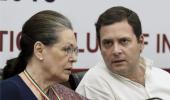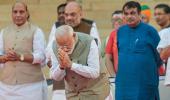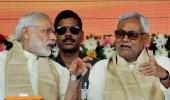'The poor manner in which the RJD stitched its alliance and mismanaged its electioneering, now reveals that Tejashwi was more interested in enhancing his political stature by cutting down many senior leaders, by downsizing and shrinking RJD allies, by displaying arrogance and inaccessibility and by committing silly mistakes in candidate selection,' points out Mohammad Sajjad.
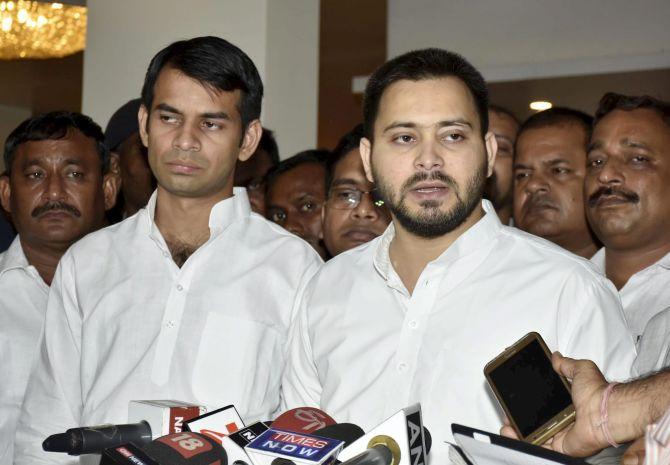
Not many may have expected that the Rashtriya Janata Dal-led Mahagathbandhan would be trounced so decisively as to get barely one seat (the Congress in Kishanganj), out of a total of 40 Lok Sabha seats in Bihar.
Not only this, most of the seats have very huge margins of defeat. Of the 19 seats contested by the RJD, just two seats -- Jahanabad, and Pataliputra (contested by Lalu's eldest daughter, Dr Misa Yadav) -- have lower margins of defeat.
In two earlier Lok Sabha elections, the RJD was reduced to 7 seats in 1999, when united Bihar had 54 seats, and 2 seats in 2014. But this is a debacle without precedent.
This verdict suggests that there is a massive rage against the RJD in Bihar.

First of all, the RJD had shown a kind of reluctance in alliance-making.
This reluctance sort of provided credence to the allegations that the RJD does not wish to reach out to non-Yadavs with a spirit of accommodation, magnanimity, power-sharing and to cementing a larger social coalition.
Many of the RJD's 'enlightened' well-wishers remained smugly contented that Muslim plus Yadav plus allies would do wonders.
They were all bereft of the ground realities, ignoring many important factors including the alienation of non-Yadavs, particularly the Ati Pichhrhas, from the RJD.
They actually dread the Yadav dynasty staging a comeback. Lured by majoritarianism and jingoism their bond with the National Democratic Alliance was further cemented.
With great delay, when it struck an alliance, it was hardly promising.
The RJD's new allies (the RLSP, VIP, HAM) did not have a cadre-base nor did they have any great ability to transfer the votes of their castes to their allies.
Their inadequacies had become largely known when they were with the BJP till recently.
In fact, this was later admitted by the BJP's Sushil Modi (external link), the deputy chief minister of Bihar, when he remarked that they left out the three, only because they did not have the ability to transfer their votes.
Nitish Kumar and R C P Singh had been assiduously working towards co-opting block and district level political workers belonging to these castes, more particularly the Koeris (Kushwahas).
Nitish's efforts had intensified in this direction ever since Upendra Kushwaha's exit from the NDA became imminent.
Mukesh Sahni's Vikassheel Insan Party does not have cadres nor is he an undisputed leader of his Mallah caste.
Secondly, the RJD's core-base is Muslims, whereas a large number of Mallahs have long been into the Bajrang Dal, particularly in north Bihar.
The communal tension and violence of Muzaffarpur (January 2015), Vaishali's Lalganj (November 2015), Saran (August 2016) witnessed Mallah aggression.
In rural north Bihar, in recent decades, the rise of the Mallahs (otherwise listed as Ati Pichhrha) has been seen with consternation and anxiety not only by the upper castes, but also by other groups.
In this scenario of latent and overt social conflicts, the Mallahs having their own political party did not go down well.
True, the BJP's Mallah candidate, Ajay Nishad, was re-elected from Muzaffarpur. But the other dominant castes felt re-assured that Ajay Nishad would be reined in by the top leadership of the BJP, a preferred political choice of the upper castes, for long.
The Madhubani seat being given away to the VIP only strengthened the misgivings of Muslims about the Mallahs.
Madhubani has around 22% Muslims. In a few earlier elections it has been represented by a Muslim candidate from the Congress. Earlier, it also elected CPI candidates.
In the 2014 Lok Sabha election, the RJD's Abdul Bari Siddiqui lost by just 16,000 votes.
The Vikassheel Insan Party first allocated its Madhubani election ticket to an RSS sympathiser. After a hue and cry, he was replaced with another Bania candidate.
Yet another instance of indecisiveness paved the ways for the emergence of rebels. Senior RJD leader and former Union minister Ali Ashraf Fatmi, reportedly on the RJD's go ahead, had been campaigning in Madhubani for many months.
He was not only denied a ticket, he was humiliated by Tejashwi when he issued a public statement at a rally that Darbhanga (a Lok Sabha seat which Fatmi had won in 1991, 1996, 1998 and 2004), Madhubani or any other seat was not anybody's bapauti (ancestral right).
All these did not go down well. Worse, it confirmed the allegation of critics and disgruntled RJD insiders that Tejashwi was arrogant.
In a way, it was a repeat of what Lalu did with Ramkripal Yadav in 2014 who quit the RJD, and joined BJP, and won the Pataliputra seat in 2014 and 2019. Abdul Bari Siddiqui, the senior RJD leader, lost Darbhanga by around 280,000 votes.
VIP chief Mukesh Sahni himself took on a Muslim candidate from the Lok Janshakti Party, Mahbub Qaisar, in Khagaria and lost.
The alliance with Jitan Manjhi suffered from the same problem. It became starkly evident on polling day in Gaya from where Manhi was the Mahagathbhandhan candidate.
Local newspaper correspondents newspapers told me that Manjhi suffered from acute booth mismanagement. Large number of booths in Gaya had no HAM workers. Nor did it have the workers of its allies like the RJD.
Mahagathbhandhan leaders did not together address election meetings nor did they together undertake mass contact programmes.
With this, a message went across that there was a lack of chemistry among the Mahagathbhandhan allies.
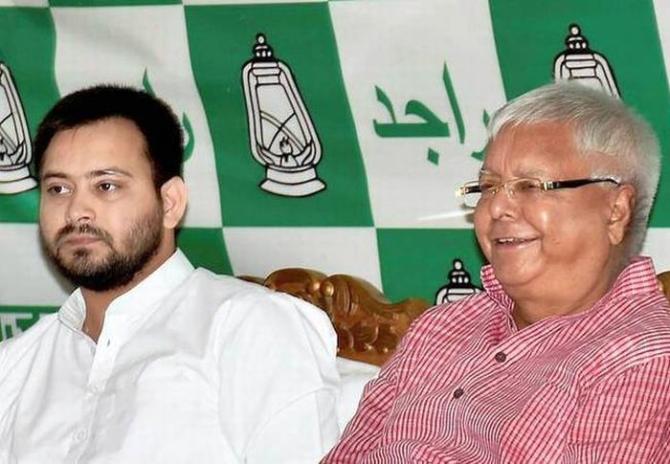
Tejashwi himself did not demonstrate much energy during his election campaign. Almost twice a week, he rested from the campaign!
He did not have a direct connect with young RJD workers at the district and block level across Bihar; not even with the Yadav cadres, what to say of cadres from other social groups!
His election speeches lacked force, passion and effect. His attack on Nitish Kumar ( 'Paltu chacha (Uncle Turncoat)') boomeranged against him.
To his audiences, Tejashwi did not explain the resemblance between the fodder scam and the Srijan scam, yet, he projected Nitish and Sushil Modi being protected by the system.
Moreover, it was a mandate for New Delhi, where regional issues did not carry much impact.
That too, in a scenario of hyper-jingoism and anti-Muslim hatred, when a significant number of Hindu voters had already made up their minds to give Modi another term.
Tejashwi should have highlighted issues raised by Rahul Gandhi such as Modi's failures on the economy, unemployment, farm distress, the Rafale deal, fleeing capitalists, hate-killings, etc.
He and all regional leaders opposed to the BJP should have displayed a resonance with each other on these issues.
The RJD's opposition to the 10% quota for poor upper castes also seems to have harmed it.
The Lalu family feuds, frequently emerging in the public domain, were as debilitating.
The emergence of three young contenders within the family -- Misa, Tejashwi, Tej Pratap -- is seen as succession warfare with hardly any scope for the political rise of others.
Ticket-distribution was flawed in many seats. A non-political novice from Magadh region was suddenly parachuted down into Sheohar.
This created anger among Mahagathbandhan voters.
This was the first election of RJD without Lalu on the scene. Tejashwi's leadership was at stake.
The poor manner in which the RJD stitched its alliance and mismanaged its electioneering, now reveals that Tejashwi was more interested in enhancing his political stature by cutting down many senior leaders, by downsizing and shrinking RJD allies, by displaying arrogance and inaccessibility and by committing silly mistakes in candidate selection.
Many Bihar-watchers surmise that Tejashwi's over-ambitious and desperate move towards making himself an obvious choice for the chief ministership in 2020 resulted in downsizing his partners and decimate potential rivals.
All these have ended up glooming Tejashwi's prospects in next year's assembly election.
Tejashwi needs to realise that it will now be very difficult for him to bargain for more seats with his allies.
Sections of Yadav youth are enamoured by Hindutva. The RJD has been out of power in Bihar for many years now, -- barring 18 months between November 2015 and July 2017 -- and lack of largesse and patronage will further erode the RJD's support base in the days to come.
The new generation of aspirational groups, particularly the youth, don't pin much hope on the RJD which is identified more with misgovernance and de-development.
Nitish Kumar may have failed on the law and order front, but the propaganda machinery still presents him as 'Sushasan Babu'.
Seventeen months till the state assembly election is a long time in politics, but the days ahead appear difficult for Tejashwi Yadav.
Mohammad Sajjad is a professor of history at Aligarh Muslim University.


